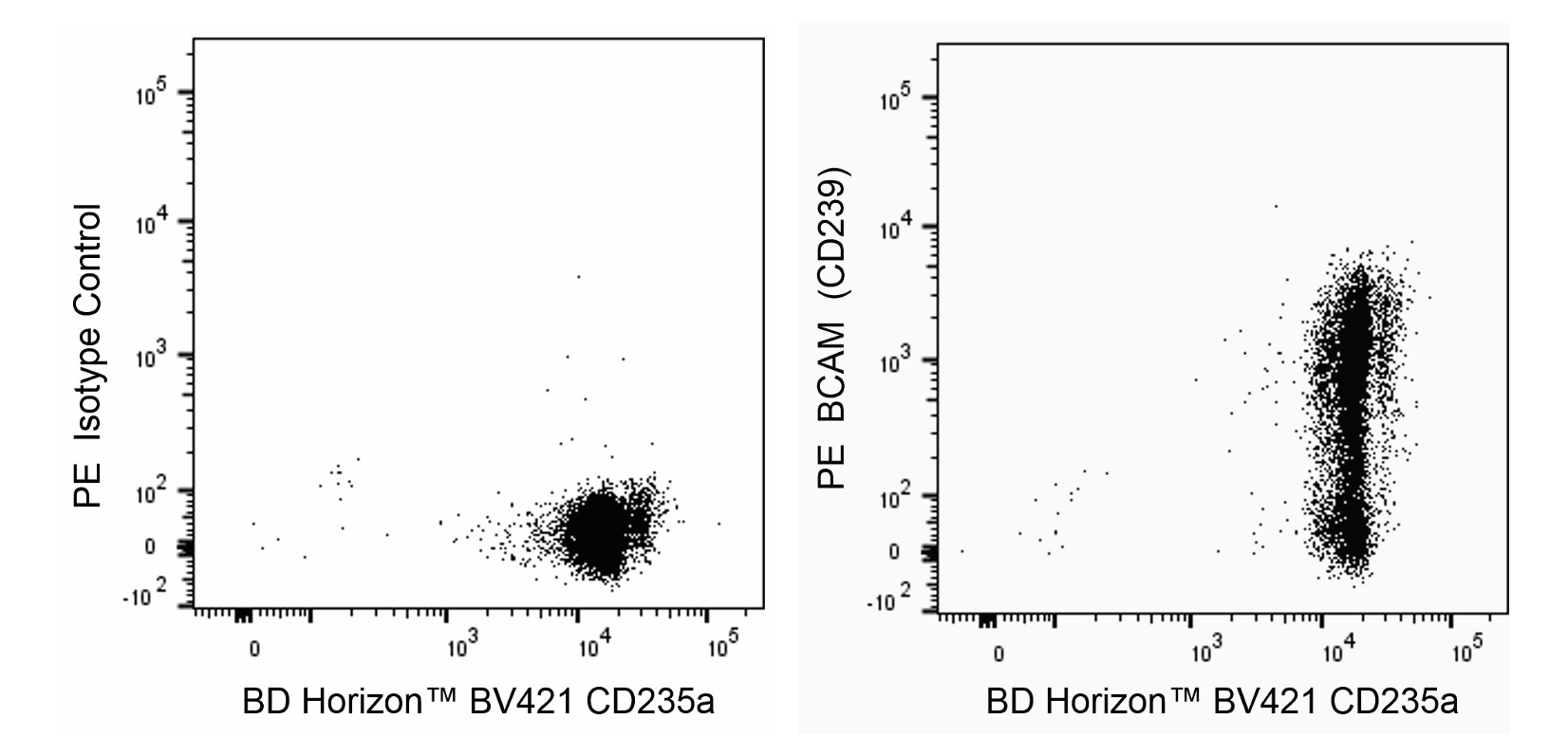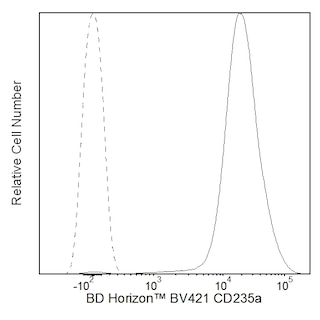Old Browser
This page has been recently translated and is available in French now.
Looks like you're visiting us from {countryName}.
Would you like to stay on the current country site or be switched to your country?




.png)

Two-color flow cytometric analysis of Human BCAM (CD239) expression on human peripheral erythrocytes. Human peripheral red blood cells were stained with BD Horizon™ BV421 Mouse Anti-Human CD235a antibody (Cat. No. 562938) and either PE Mouse IgG2a, κ Isotype Control (Cat. No. 554648; Left Plot) or PE Mouse Anti-Human BCAM (CD239) antibody (Cat. No. 566661; Right Plot) at 0.5 µg/test. Two-color flow cytometric dot plots showing the correlated expression of CD235a versus BCAM (CD239) [or Ig Isotype control staining] were derived from gated events with the forward and side light-scatter characteristics of viable red blood cells. Flow cytometric analysis was performed using a BD FACSCanto™ II Flow Cytometer System. Data shown on this Technical Data Sheet are not lot specific.

Immunohistochemical staining of Human BCAM (CD239) in human tonsil. Frozen sections of human tonsil were fixed with cold acetone, washed, and then stained with either Purified Mouse IgG2a κ Isotype Control (Cat. No. 550339; Left Image) or Purified Mouse Anti-Human BCAM (CD239) antibody (Right Image). A three-step staining procedure that employs a Biotin Goat Anti-Mouse Immunoglobulin (Cat. No. 550337), Streptavidin-Horseradish Peroxidase (HRP) (Cat. No.550946), and the DAB Substrate Kit (Cat. No. 550880) was used to develop the primary staining reagents. As shown in the Right Panel, the Purified Mouse Anti-Human BCAM (CD239) antibody specifically stained vascular endothelial cells of vessels. Original magnification: 20×.
.png)

BD Pharmingen™ PE Mouse Anti-Human BCAM (CD239)

BD Pharmingen™ PE Mouse Anti-Human BCAM (CD239)
.png)
Regulatory Status Legend
Any use of products other than the permitted use without the express written authorization of Becton, Dickinson and Company is strictly prohibited.
Preparation And Storage
Product Notices
- Since applications vary, each investigator should titrate the reagent to obtain optimal results.
- An isotype control should be used at the same concentration as the antibody of interest.
- Caution: Sodium azide yields highly toxic hydrazoic acid under acidic conditions. Dilute azide compounds in running water before discarding to avoid accumulation of potentially explosive deposits in plumbing.
- Please refer to www.bdbiosciences.com/us/s/resources for technical protocols.
- For fluorochrome spectra and suitable instrument settings, please refer to our Multicolor Flow Cytometry web page at www.bdbiosciences.com/colors.
Companion Products






The B64 monoclonal antibody specifically recognizes Basal Cell Adhesion Molecule (BCAM, B-CAM) which is also known as CD239, Lutheran blood group antigen (Lu), or Lutheran glycoprotein. BCAM (CD239) is a type I transmembrane glycoprotein that is encoded by BCAM [basal cell adhesion molecule (Lutheran blood group)] which belongs to the Ig gene superfamily. Full-length BCAM (CD239) is comprised of an extracellular region with two N-terminal V-type Ig-like domains followed by three C2-type Ig-like domains, a transmembrane region, and cytoplasmic domain of 59 amino acid residues. The extracellular region of this adhesion molecule functions as a receptor for α5-chain containing laminins which are found in basement membranes whereas its cytoplasmic tail may have signal-transduction functions. BCAM (CD239) is expressed on erythrocytes and on the basal layer of vascular endothelial cells or some epithelial cells. BCAM (CD239) is highly expressed on sickle red cells and may play a role in vaso-occlusive crises in sickle cell disease. It is also upregulated upon malignant transformation of some cell types including those found in ovarian carcinomas.

Development References (4)
-
Kikkawa Y, Miner JH. Review: Lutheran/B-CAM: a laminin receptor on red blood cells and in various tissues.. Connect Tissue Res. 2005; 46(4-5):193-9. (Biology). View Reference
-
Wautier MP, El Nemer W, Gane P, et al. Increased adhesion to endothelial cells of erythrocytes from patients with polycythemia vera is mediated by laminin alpha5 chain and Lu/BCAM.. Blood. 2007; 110(3):894-901. (Biology). View Reference
-
Zen Q, Cottman M, Truskey G, Fraser R, Telen MJ. Critical factors in basal cell adhesion molecule/lutheran-mediated adhesion to laminin.. J Biol Chem. 1999; 274(2):728-34. (Biology). View Reference
-
Zola H, Swart B, Nicholson I, Voss E. CD239. In: Zola H. Leukocyte and stromal cell molecules : the CD markers. Hoboken, N.J.: Wiley-Liss; 2007:393-394.
Please refer to Support Documents for Quality Certificates
Global - Refer to manufacturer's instructions for use and related User Manuals and Technical data sheets before using this products as described
Comparisons, where applicable, are made against older BD Technology, manual methods or are general performance claims. Comparisons are not made against non-BD technologies, unless otherwise noted.
For Research Use Only. Not for use in diagnostic or therapeutic procedures.
Report a Site Issue
This form is intended to help us improve our website experience. For other support, please visit our Contact Us page.